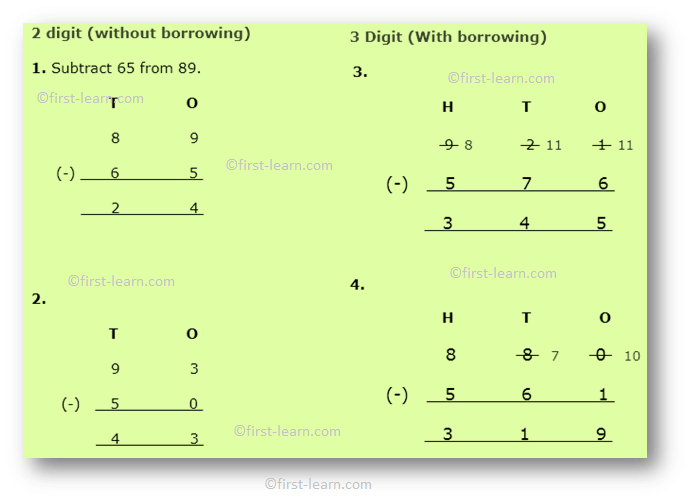Subtraction of Whole Numbers
As we have discussed in previous topics whole number is almost same as natural numbers except the fact that it includes zero. However, natural numbers are {1, 2, 3, 4, 5, 6……} whereas whole numbers are {0, 1, 2, 3, 4, 5, 6, 7……}. Hence we can say that all natural numbers are whole numbers but all whole numbers are not natural numbers as it includes zero. Whole numbers are sometimes termed as counting number. However, counting number does not include zero as zero cannot be counted. Therefore counting numbers including zero is termed as whole number.
The four basic operations with whole numbers are addition, subtraction, multiplication, and division. Now we will understand how subtraction of whole numbers is done.
Steps for conducting subtraction of whole numbers:
I. First we have to write the numbers under proper heads of ones, tens, hundreds, thousands, ten thousands……..etc.
II. Then we have to start subtracting from the right hand side. Subtraction can be with borrowing or without borrowing. If borrowing is needed then we have to borrow from the tens column to make adjustment in the ones column. Accordingly if borrowing is needed in the tens column then we will have to borrow from the hundreds column to make adjustment in the tens column and so on and so forth we have to continue likewise.
Solved Examples of Subtraction of Whole Numbers:
2 digit (without borrowing)
1. Subtract 65 from 89.
T O
8 9
(-) 6 5
2 4
In ones place 5 is subtracted from 9 to get 4 and in the tens place 6 is subtracted from 8 to get 2.
2.
T O
9 3
(-) 5 0
4 3
In ones place 0 is subtracted from 3 to get 3 and in tens place 5 is subtracted from 9 to get 4.
3 Digit (Without borrowing)
3.
H T O
9 8 7
( -) 6 5 4
3 3 3
In ones place 4 is subtracted from 7 to get 3 and in tens place 5 is subtracted from 8 to get 3. Similarly 6 is subtracted from 9 to get 3.
4.
H T O
4 5 6
(-) 1 2 3
3 3 3
In ones place 3 is subtracted from 6 to get 3 and in tens place 2 is subtracted from 5 to get 3. Similarly 1 is subtracted from 4 to get 3.
3 Digit (With borrowing)
5.
H T O
9 8 2 11 1 11
(-) 5 7 6
3 4 5
6 cannot be subtracted from 1. Hence 1 is borrowed to make the number in the ones place as 11. So the number in the tens place that is 2 became 1. Now same issue in the tens place that is 7 cannot be subtracted from 1 again. Hence, 1 is borrowed from 9 to make it 8. Now in the tens place after borrowing 7 can be subtracted from 11. Finally in the hundreds place there is no need of borrowing as 5 can be subtracted from 8.
6.
H T O
8 8 7 0 10
(-) 5 6 1
3 1 9
0 cannot be subtracted from 1. Hence 1 is borrowed to make the number in the ones place as 10. So the number in the tens place that is 8 became 7. Now 6 can be subtracted from 7 in the tens place so no borrowing from the hundreds place required.
The same rule of subtraction with borrowing is prevalent for 4 digit, 5 digit, 6 digit and so on for every number.
From Subtraction of Whole Numbers to HOME PAGE
Recent Articles
-
What Is Plasma? | Blood Plasma | Proteins | Nutrients | Cholesterol
Nov 07, 25 10:29 AM
Blood is a mobile fluid which is a connective tissue and is derived from the mesoderm like cell any other connective tissue. Colour of blood is reddish and that flows inside the blood vessels by means… -
Disorders of Respiratory System | Tuberculosis | Pleurisy | Emphysema
Oct 28, 25 11:39 PM
Tuberculosis is very common disease and is caused by a type of bacteria called Mycobacterium tuberculosis. This disease causes different trouble in the respiration and infection of several parts of th… -
Regulation of Respiration | Respiratory Centres | Inspiratory Area |
Oct 14, 25 12:13 AM
Respiratory Centre is the area that controls the rate of respiration and it is observed to be located in medulla oblongata and pons. Respiratory Centre has the following will dispersed components like… -
Explain Transport of Gases | External Respiration | Tissue Respiration
Oct 09, 25 11:35 PM
In humans gaseous exchange is completed in the following ways the steps are - External Respiration or Breathing - Breathing in false taking in of Oxygen and giving out of carbon dioxide in the body. M… -
Kind and Number of Teeth | Location of Teeth in Mouth | Care of Teeth
Sep 11, 25 12:52 AM
Kind and Number of Teeth






New! Comments
Have your say about what you just read! Leave me a comment in the box below.